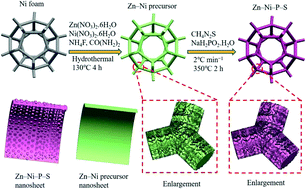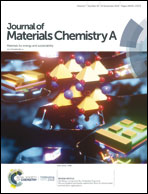Bimetallic phosphosulfide Zn–Ni–P–S nanosheets as binder-free electrodes for aqueous asymmetric supercapacitors with impressive performance†
Abstract
Although Ni–P based metal phosphides have high theoretical specific capacity, the poor rate capability and cycling stability hinder their practical application. Herein, we report bimetallic phosphosulfide Zn–Ni–P–S 2D nanosheets (ZNPS) by introduction of Zn cations and S anions into Ni–P metal phosphides, and they exhibit high rate capability and cycling stability in an aqueous asymmetric supercapacitor. The as-prepared ZNPS electrode shows a high specific capacity of 1180 C g−1 at 2 A g−1 in a three-electrode system. The ZNPS utilized in a two-electrode system shows a high energy density of 29.01 W h kg−1 at a power density of 275.54 W kg−1 and outstanding cycling stability (100% capacity retention after 15 000 cycles) and superior rate capability (94.99% capacity retention when the current density increases from 0.2 A g−1 up to 1 A g−1). The simple and new strategy for ZNPS synthesis opens a path to design new electrode materials for aqueous asymmetric supercapacitors with an impressive performance.



 Please wait while we load your content...
Please wait while we load your content...